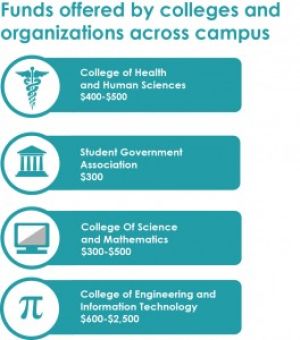Colleges provide funding for students
October 7, 2013
Georgia Southern University students have the opportunity to apply for funding for undergraduate research or conferences through their college, although each college’s funding process and amount is different.
“Typically the dean’s office has a budget but each of the departments has their own budget, and within their budget each of the department chairs may choose to fund students,” Barry Joyner, Ph.D., interim dean of the College of Health and Human Sciences (CHHS), said.
The College of Engineering and Information Technology (CEIT) provides students with options when acquiring funding.
If a student or group of students is on a competition team, such as Eagle Motor Sports, they can apply to the department, while students partaking in research with faculty can utilize CEIT funds, Mohammad Davoud, Ph.D., dean of CEIT, said.
Students partaking in research and presenting at a conference usually have a higher chance of receiving greater funds.
“We think it’s a great experience just for students to go to the conferences, but if they are presenting with a faculty member then we really don’t want students to pay a lot out of pocket for that,” Joyner said.
The College of Science and Mathematics (COSM) provides students with a small grant through the College Office of Undergraduate Research which is dedicated mostly to students of any year who are presenting their work at a conference or in a competition, such as Math Jeopardy, Martha Abell, Ph.D., interim dean of COSM, said.
Some faculty mentors are able to help students through the grants that they receive for research.
The Student Government Association provides individual students a maximum of $300 and student groups and organizations can receive up to $600 through an application available on myInvolvement.
Each college sets aside a certain amount of money for students’ participation in conferences and research. The amount depends on the college’s budget.
“So last year for example, I funded I think close to thirty students as much as anywhere from between, let’s say, six hundred to seven hundred dollars to twenty-five hundred or so, funding for them to buy materials, equipment and other things to do their project with their faculty-professor,” Davoud said.
In CHHS, probably $400 to $500 was given to students for funding with around 15 to 20 applying, Joyner said.
“We provide anywhere from one hundred fifty to two hundred dollars per student per academic year combined either research or professional development,” James McMillan, Ph.D., interim chairperson for Department of Health and Kinesiology, said.
COSM funding for students usually ranges between $300 and $500, Abell said.
The degree to which the information for funding is publicized varies by college as well.
“I think anyone who has done the work naturally will apply, or it is built into their initial request when they do projects, or we have found other avenues for them to travel,” Davoud said.
For COSM students, most information regarding funding is received through their major club because that is the easiest way to reach students, Abell said.
In the exercise science area and the masters programs it is well-known information but in other areas the information may not be as known, McMillan said.
“I think we try to but I don’t think there is a consistent effort across colleges or across departments to do that,” Joyner said.
A common theme to determine how much money a student receives includes submitting a proposal and budget.
“Generally I think the departments are going to cover whatever their students can’t,” Abell said. “I know when I was honors director I would tell the students that their contribution is to buy their food.”
Davoud said, “I wouldn’t worry about funding if I was a student, I would get engaged in undergraduate research and produce publications and hope for the presentations and funding will come from one place or another.”









